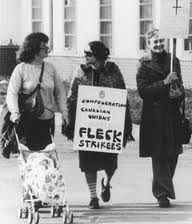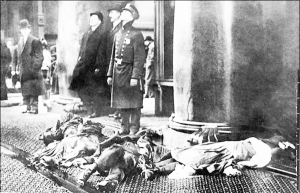By Alex Hunsberger, CUPE
The defeat of Hudak in the June 12 Ontario general election was indeed remarkable. The Liberals, meanwhile, campaigned to the left, presenting themselves as the progressive alternative to the PCs hard-right austerity program, winning a majority government on that basis.
Their apparent credibility as a genuine progressive voice was enhanced by the decision of the NDP to put forward a centrist platform void of anti-austerity rhetoric that largely focused on combating Liberal corruption.
Central to the Liberals’ claim that they were easing austerity and focusing on improving public services was their proposed Budget 2014, which increased spending and maintained a substantial deficit while promising certain reformist measures like a new Ontario pension plan. Anger at the NDP’s rightward drift led some to believe the Liberal hype that their budget was a progressive alternative. But a close reading of Budget 2014 reveals that it is at its core a plan for several more years of harsh austerity across all sectors.
Overall austerity for at least three more years
The plan is for spending to be essentially flat lined in the first year. Then in the following two years, the government proposes much harder fiscal tightening, increasing overall spending by just 0.6 per cent in 2015-16 and 0.1 per cent in 2016-17.
The government’s own estimates indicate it expects inflation to rise to 2.0 per cent after this year and for population growth to continue at 1.0 per cent due to natural increases and positive net migration.
In other words, to maintain services at current levels (i.e. sustain current real per capita program spending), a 3.0 per cent annual spending increase is needed. In just three years, then, the government plans to slash real per capita program spending by 5.3 per cent from current levels.
What do these numbers mean for users of public services and the workers who provide them? The short answer: for users, poorer quality service and higher user fees; for workers, wage freezes, cuts to benefits, and higher workloads. No sector will be unaffected.
Health cuts hurt patients and workers
Hospitals have already seen a budget freeze for two years, not having received increases in their base operating funding in either 2012-13 or 2013-14. The government confirms it will continue the freeze in 2014-15, and based on flat-lined overall program spending over the next two years it is safe to assume the freeze will continue for two additional years. This means five consecutive years of 0 per cent increases for hospitals, and amounts to a massive austerity program. There is no way such cuts can go forward without affecting the quality of patient care and working conditions
Attacks on higher education
The Ontario Liberals have consistently billed themselves as the defenders of a strong post-secondary education system. But after a modest $200 million increase in funding this year, Budget 2014 proposes freezing spending for the Ministry of Training, Colleges, and Universities at $7.8 billion in 2015-16 and 2016-17.
Ontario will likely keep the dubious honour of having the highest tuition fees in the country.
The continuing assault on free collective bargaining
Trade unionists in the public sector know that the bargaining climate in the past couple years has been particularly difficult and acrimonious. In the broader public sector, unions have made major concessions, either “voluntarily” with the threat of legislative intervention looming or, for those unions that resist, through the actual imposition of special legislation.
OPSEU members in the core public service fall into the former camp, having agreed last year to a two-year wage freeze. Public school teachers are an example of the latter case, having had a contract imposed on them through Bill 115 that handed them a two-year wage freeze alongside rollbacks to sick leave benefits
Budget 2014 explicitly plans for a concessions climate for at least three more years. The government is putting no money in the budget for negotiated compensation increases, even to allow salaries to keep up with inflation. Since no union is likely to agree to a five-year wage freeze, particularly on top of other concessions, Wynne’s claim to respect free collective bargaining will no doubt be revealed once again to be a charade as the government moves to impose austerity on workers by force.
Who pays for the global economic crisis?
The Wynne government’s political strategy to move forward with austerity is to pit public sector workers against private sector workers, blaming the former for the falling living standards of the latter. Any time public sector workers attempt to negotiate better working conditions—or, more commonly in the current climate, maintain what they already have—the government argues that greedy workers are to blame for the declining quality of public services. Nothing could be further from the truth.
Ontario has a substantial deficit not because of profligate spending or skyrocketing public sector salaries but because the 2008 financial crisis depressed government revenues while forcing the province to increase spending to prevent complete economic collapse. The government brags in Budget 2014 that it takes in the least revenue and spends the least on programs per capita out of all ten provinces. It also advertises that it has been a tough employer at the bargaining table.
The reality is that workers in both the public and private sectors are paying for the crisis capitalists—and capitalism—caused. Corporations operating in Ontario are enjoying record-low taxes due to years of federal and provincial rate cuts, as well as lucrative subsidies, while workers are being told the cupboards are bare when it comes to important public services.
From anti-Hudak to anti-austerity
While claiming progressive credentials, the Liberals like the PCs are a party of a capitalist class that is fully committed to the neoliberal austerity project. Trade unionists are now faced with the sober reality that defeating Hudak did not defeat the austerity agenda he championed.
The task ahead is to build on the momentum the fight against Hudak has generated in the labour movement, as well as the inevitable disappointment of those still hoping the Liberals will offer a real alternative, to make the case that we need to continue to fight against austerity agenda.










